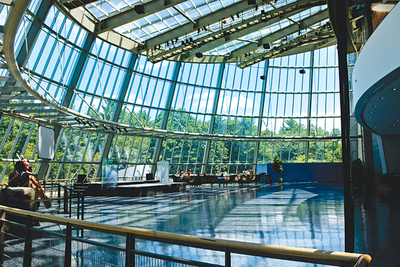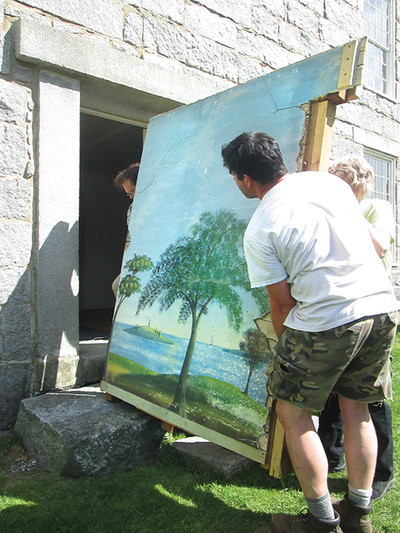Quirky, Majestic, Tranquil

Gathering space of the Mashantucket Pequot Museum & Research Center. Photo: Sassy Mouth Photography.
New England is the home of museums of all sizes, with offerings both broad and focused. The six featured here, one for each state, underscore the breadth of the region’s cultural diversity and heritage, drawing on history but also contemporary aesthetics to engage new audiences—and entice the regulars to make a return visit.
While a few of these venues are open year-round, for most summer is the time to make hay, mounting special shows or highlighting new acquisitions. Here are their stories.
Maine Wood(s)
May 4–October 15, 2017
L.C. Bates Museum
Hinckley, ME
gwh.org/lcbates/lcbatesmuseum.aspx
The L.C. Bates Museum is one of Maine’s most satisfyingly quirky venues for art. The two-story Romanesque Revival brick building off Route 201 in Hinckley is first and foremost a cabinet of curiosities, a collection of natural history dioramas, stuffed animals (including an Atlantic blue marlin caught by Ernest Hemingway) and assorted minerals. The renowned biologist Bernd Heinrich had his start here, hiding his collection of caterpillars in the museum’s basement when he was a student at the Good Will-Hinckley School next door.
Since its landmark exhibition Looking at Katahdin in 1999—the first show highlighting the art inspired by Maine’s tallest mountain—the museum has increased its visibility, and visitors, through special thematic summer shows that often revolve around place. For the past three summers, Colby College students under the supervision of art professor and historian Véronique Plesch have helped curate the shows. This time around Arianna Finger and Ellis Grubman, both class of 2019, set out to explore the Maine woods.
The 25 artists in the exhibition consider the concept of woods from a wide range of perspectives and by way of diverse mediums. Portland artist Alison Hildreth’s ink-and-watercolor Communication, 2017, with its vein-like networks reflect her interest in root systems “that can expand to thousands of acres…and can communicate and provide essential nutrients to their hosts, including trees and other plant life.” Mary Hart’s etching Seedling, 2010, and John Woolsey’s acrylic gouache on wood, Forest Interior 4, 2016, are other stand-outs.
Edward Gorey’s Cabinet of Curiosities
Through December 31, 2017
Edward Gorey House
Yarmouth Port, MA
edwardgoreyhouse.org
Back in the late 1970s, I encountered the master of the macabre Edward Gorey (1925–2000) at the Gotham Book Mart on West 45th Street in Manhattan. It was hard to miss him: he wore a colorful, full-length fur coat just like many of his characters. The Edward Gorey House is dedicated to celebrating the life and preserving the works of this brilliant author, illustrator, playwright and set and costume designer with displays that underscore his “distinct personality.”
In addition to ongoing displays, the Gorey House mounts special exhibitions. This year’s Edward Gorey’s Cabinet of Curiosities showcases some of the artwork, relics, artifacts, knick-knacks and oddities he gathered in the Elephant House, his pet name for the 1820s Yarmouth Port sea captain’s home he lived in for the last 21 years of his life. This “five-room sampler” is meant to provide some insight into what appealed to Gorey’s imagination and set him to work. Curiosities include yard sale art; antiquities, real and faux; potato mashers and cheese graters; bones and mummy parts; toys and figurines; and postcards and ticket stubs.
This year the museum will once again offer the Gashlycrumb Tinies scavenger hunt, which was launched in 2005. Inspired by Gorey’s The Gashlycrumb Tinies (1963), the hunt invites visitors to look for references to the rhymes in this grisly abecedarian, in which “E is for Ernest who choked on a peach/F is for Fanny sucked dry by a leech.”
Without a Theme
Mashantucket Pequot Museum &
Research Center
Mashantucket, CT
Through November 2, 2017
pequotmuseum.org
Tribally owned and operated since it opened in 1998, the Mashantucket Pequot Museum & Research Center—a dramatic glass and steel structure—is dedicated to furthering the understanding of the richness and diversity of the native cultures and societies of the northeast United States and Canada.
The center builds its yearly programming around a single exhibition. This year is Without a Theme, an “immersive” show consisting of approximately 20 installations by seven North American artists: Jeff Kahm, Saskatchewan, Canada; Bob Haozous, New Mexico; Allan Houser, Oklahoma; Courtney Leonard, New York; Isaac Dial, Utah; Russell Frye, New Mexico; and Joe Feddersen, Washington. The installations will be set up “in mindful contrast” to popular Native American exhibitions “in which emphasis is placed on the artist’s heritage or on visual themes that don’t necessarily convey modern Native life,” according to Pequot Museum curator Tahnee Ahtoneharjo-Growingthunder.
Artist and filmmaker Courtney Leonard, a member of the Shinnecock Indian Nation on Long Island, continues her ongoing conceptualization of the word “breach” in this exhibit with Breach #2, where she investigates “narratives of cultural viability as a reflection of environmental record.” She gained attention last summer for her contribution to the show Radical Seafaring at the Parrish Art Museum in Water Mill, NY, where she offered a wood pallet heaped with shimmering sperm whale teeth formed from clay—a commentary on the history of whaling.

Historical house restorer and Porter expert David Ottinger (far left) guides the delivery of the Porter murals to Vermont, May 2016. Courtesy of the Old Stone House Museum, Brownington, VT.
Rufus Porter Murals
Old Stone House Museum
Brownington, VT
May 15–October 15, 2017
oldstonehousemuseum.org
The Old Stone House Museum has had an eventful year. In July it moved the historic Orleans County Grammar School—by oxen no less—to its original site where it will be renovated and used for programming and education. The museum also acquired 13 murals painted by Rufus Porter (1792–1884). A self-taught itinerant artist, Porter, who was born in West Boxford, MA, traveled across New England and beyond as a “short-order portraitist” and mural painter. He also founded Scientific American magazine.
The Porter murals at the Old Stone House Museum are rare examples of stencil painting used to decorate historic buildings. Over time, many of these murals were lost to renovations, fires and other damaging events. Fortunately, the Porter murals in the Adams Female Academy in Derry, NH, were covered over and thereby largely preserved. Except for one missing piece, the panels are intact. Their new home is a fitting one: the Old Stone Museum is housed in what was once a student dormitory, Athenian Hall, built in 1836 by Alexander Twilight, the first person of African American heritage to graduate from an American college.
Porter developed a technique for painting directly on horsehair plaster. The rescued murals include his bread and butter subject matter: hilly rural landscapes with fields and houses. Each one of the wall sections is linked by color and design to the next. Linda Lefko, an authority on Porter, has noted that the panels should remain together “as a cohesive group…as they show a continuity of form and color.”
Gerald Auten
Aidron Duckworth Art Museum
Meriden, NH
Through June 4, 2017
aidronduckworthmuseum.org
The Aidron Duckworth Art Museum, which opened in 2002, houses more than 1,300 works by the British artist, teacher and writer who lived in Meriden, NH, from 1976 until his death in 2001. A 1954 graduate of the Royal College of Art in London, Duckworth taught 3-D art in South Africa, England and the U.S. In his time in New Hampshire, he offered private art lessons. He transitioned from sculpture to painting in the 1970s. He sought to represent what he called the “enigmatic-natured being” in his work.
In addition to presenting the work of its namesake, the Duckworth Museum mounts special shows. They launched a guest artist program in 2008. They will kick off the summer season with work by Gerald Auten, director of exhibitions and senior lecturer in studio art at Dartmouth College. He will focus his show on several architecture projects done over the past 25 years “that examine power.” The exhibition will include an edited version of a nuclear waste repository that Auten designed for the mall in Washington, D.C.
Later in the season, the museum will host Laura Moriarty (June 10–July 23) and Ernest Montenegro (June 10–October 29). From Kingston, NY, Moriarty makes process-driven sculptural paintings and works on paper whose forms, colors, textures and patterns, she states, “result from the same processes that shape and reshape the earth: heating and cooling, erosion, subduction, friction, enfolding, weathering, slippage.” Montenegro, whose home base is Claremont, NH, will be showing his dynamic figural bronzes on the grounds of the museum.

National Museum of American Illustration’s entrance and east facade, © 2017 National Museum of American Illustration™, Newport, RI, americanillustration.org.
Norman Rockwell and His Contemporaries
National Museum of American Illustration
Through May 26, 2017
Newport, RI
americanillustration.org
Of the six museums highlighted here, the National Museum of American Illustration is the most glamorous: It is housed in Vernon Court, an “interpretation” of an 18th-century French chateau that was designed by the New York City architects Carrère and Hastings. The museum is devoted to presenting the work of American illustrators active during the Golden Age of illustration (the 1880s to the 1920s), but also explores the art of more contemporary practitioners.
The main draw through May is a show dedicated to that creator of iconic images of American life, Norman Rockwell (1894–1978). His work is ubiquitous—in reproduction, in satire, even in last year’s The People v. O.J. Simpson: In trying to improve the football player’s image, his lawyers redecorated his house in advance of the jurors’ visit, hanging a print of Rockwell’s classic 1963 painting The Problem We All Live With, which shows the young black girl Ruby Bridges walking to class escorted by federal marshals.
Rockwell’s work is joined by that of five of his artist-illustrator contemporaries: John Falter, Mead Schaeffer, John Clymer, Stevan Dohanos, and George Hughes. The five offer an appealing range of subjects, from Clymer’s scenic renderings of the American West to Schaeffer’s illustrations for adventure novels.
Five other shows run concurrently: American Muse; Advertising as Art; John Rogers: The Norman Rockwell of Statuary; Secrets Behind the Wall: The Don Trachte Replicas and My Little Pony: Under the Sparkling Sea by Mary Jane Begin. The last-named exhibition highlights the museum’s efforts to reach into new illustration realms: Begin was chosen by the Hasbro toy company to illustrate the latest in the My Little Pony children’s book series.
Carl Little’s latest book is Wendy Turner~Island Light (Portsmouth Marine Society).
